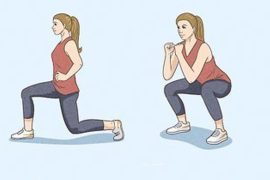Walking is often overlooked as a powerful workout, with many people turning to intense exercises or strict diets for quick weight loss. However, incorporating a simple walking routine, like the 6-6-6 walking regimen, into your daily life can have significant health benefits. This easy-to-follow pattern involves walking for six minutes at a moderate pace, followed by six minutes of brisk walking, and then another six minutes at a moderate pace. This method effectively boosts cardiovascular health, burns calories, and aids in weight loss. It also improves endurance, strengthens muscles, and can be a sustainable, low-impact exercise option for overall wellness.
6-6-6 walking:
The 6-6-6 walking routine is a straightforward yet effective approach to fitness. It involves walking for a total of 60 minutes, either at 6 a.m. or 6 p.m., to suit your schedule. To maximize the benefits, fitness expert Mahesh Ghanekar recommends incorporating a 6-minute warm-up before the walk, which could include light stretching and mobility exercises like arm circles and neck stretches. After your walk, a 6-minute cool-down session with gentle stretches helps with muscle recovery and reduces the risk of soreness. By adopting this routine, you can significantly improve your overall health and well-being, making walking a sustainable and enjoyable part of your fitness journey.
The 6-6-6 walking routine is a balanced approach to daily walking that incorporates specific timings and durations to maximize health benefits. Here’s a detailed guide on how to follow this routine effectively:
1. Start with a 6 AM Morning Walk
- Why: Walking early in the morning, especially at 6 AM, provides multiple benefits. The fresh air and serene environment help boost your metabolism, improve lung function, and reduce stress. Studies have shown that outdoor walking can enhance your energy levels and mood throughout the day. A morning walk can also increase mental clarity and cognitive function, particularly in elderly individuals.
- Tip: Use this time to center yourself mentally, focus on your breathing, and enjoy the calmness before the day begins.
2. De-stress with an Evening Walk at 6 PM
- Why: Walking in the evening helps release the physical and mental tension built up throughout the day. A brisk 6 PM walk supports digestion, helps regulate blood glucose levels, and promotes relaxation. Research in the Journal of Diabetes Care suggests that evening walks can assist with weight management and reduce the risk of chronic conditions. They are also beneficial for improving sleep quality and managing anxiety.
- Tip: Make this walk a form of unwinding, where you can clear your mind, reflect on the day, and mentally transition to the evening.
3. Walk for 60 Minutes a Day
- Why: A total of 60 minutes of walking per day helps improve cardiovascular health, manage weight, and reduce the risk of chronic diseases such as diabetes and heart disease. Walking regularly can also boost cognitive function, reduce stress, and enhance overall well-being. Even 30-60 minutes of exercise per week has long-term health benefits, such as lowering the risk of all-cause mortality.
- Tip: Split your walk into two 30-minute sessions (morning and evening) or go for a continuous hour-long walk, depending on your schedule.
4. Warm-Up for 6 Minutes
- Why: Warming up before any physical activity increases blood flow to your muscles, which reduces the risk of injury and enhances performance. A gentle warm-up can improve your flexibility, muscle function, and coordination. As the International Journal of Creative Research Thoughts suggests, warming up also reduces post-exercise muscle soreness.
- Tip: Start with a brisk walk or light stretches to gradually increase your heart rate and prepare your body for the upcoming walk.
5. Cool Down for 6 Minutes
- Why: Cooling down helps transition your body from an active state to a resting state. It allows your heart rate and breathing to gradually slow down, reducing the chances of dizziness or muscle cramps. The cool-down also aids in muscle recovery by flushing out toxins and decreasing muscle tightness, enhancing flexibility and range of motion.
- Tip: End your walk with slower-paced walking and light stretching to promote muscle recovery and maintain flexibility.
By following the 6-6-6 walking routine, you’ll integrate physical activity into your daily schedule, supporting cardiovascular health, weight management, and overall well-being. Consistency is key, so stick to this routine and enjoy the numerous benefits for both your body and mind.
Disclaimer:
The information contained in this article is for educational and informational purposes only and is not intended as a health advice. We would ask you to consult a qualified professional or medical expert to gain additional knowledge before you choose to consume any product or perform any exercise.







